Enzyme has its unique
properties. Enzyme reacts with the substrate and catalyzes the particular
metabolic reaction into the body. Enzyme and substrate reaction can be
explained by the lock and key model.
Here the some unique
properties and the characteristic of the Enzymes.
Enzyme is the
sensitive:
Enzyme is highly
sensitive for pH, Temperature, alcohol. Enzyme may be getting inactive due to the
excessive heat. Enzyme gets denatured by the excessive heat.
Enzymes act only in specific pH ranges and any
changes can adversely affect their action and efficiency. Most intracellular
enzymes function best at neutral pH.
Enzyme is Rapid:
Enzyme rapid action can
catalyze the reaction without enzyme the reactions are very slow. The rate of
reaction is very high in presence of the enzyme.
Enzyme has a
variety of cellular controls:
Rate of synthesis
and the concentration at a given time and under the control situation
Enzymes are Not destroyed or Altered after
reaction:
Enzymes are re-used after using into the reaction.
they are different from inorganic catalysts that stable and that can be re-used
over and over again indefinitely.


